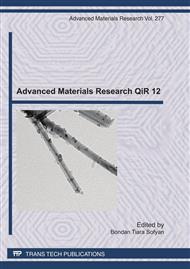p.90
p.100
p.106
p.112
p.120
p.129
p.137
p.143
p.151
Analysis of the Fe-Ti and Mg-Ti-Fe Alloys Prepared by High Energy Ball Milling and their Hydrogen Capacity
Abstract:
The synthesis and characterizations of Fe-Ti and Mg-Ti-Fe alloys with the atomic ratio of Fe:Ti = 2:1 and Mg:Ti:Fe = 2:5:6 prepared by mechanical alloying technique in toluene solution and measurement the hydrogen absorption properties of the yields have been performed. The Fe-Ti and Mg-Ti-Fe elemental powders are milled with the milling time of 30 h, in a Mixer Mill, type PW 700i high energy ball mill. The milled specimens are analyzed with an X-ray diffractometer, Philip, type PW 1710, using Cu as the anode tube and l = 1.5406 Å. Qualitative and quantitative analyses are determined using Rietveld method developed by Fuji Izumi. The microstructure of the specimens after milling and hydriding are identified with a scanning electron microscope, Philip type 550. The refinement analysis of the x-ray diffractions results for Fe-Ti alloy shows that before milling the specimen consists of Ti and Fe phases, and after 30 h of milling new phases identified as FeTi and Fe2Ti are formed. In case of Mg-Ti-Fe alloy after 30 h of milling new phases identified as Fe2Ti and FeTi compounds are formed with the absence of Mg-Ti and Mg-Fe. Quantitative analysis of the milled powders shows that the mass fractions of FeTi and Fe2Ti phases are correspondingly 22.5 wt% and is 21.1 wt%, and the rest is Fe. The disappearance of Mg peaks after milling is suggested from the transformation of the crystallite into amorphous state. On hydriding at room temperature, the milled Fe-Ti and Mg-Fe-Ti powders are transformed into b-Ti4FeH8.5, Fe and TiH2. Considering the high hydrogen capacity and the low hydriding temperature of the Mg-Ti-Fe alloy compared to those of Fe-Ti alloy, the Mg-Ti-Fe alloy could be promoted as a new hydrogen storage material.
Info:
Periodical:
Pages:
129-136
Citation:
Online since:
July 2011
Authors:
Price:
Сopyright:
© 2011 Trans Tech Publications Ltd. All Rights Reserved
Share:
Citation:


